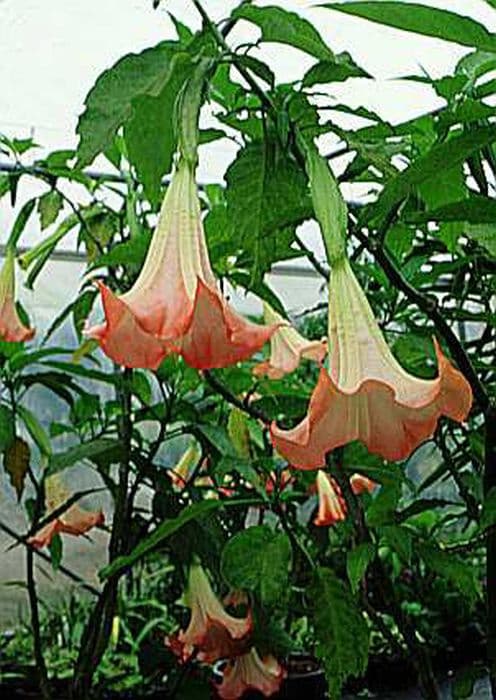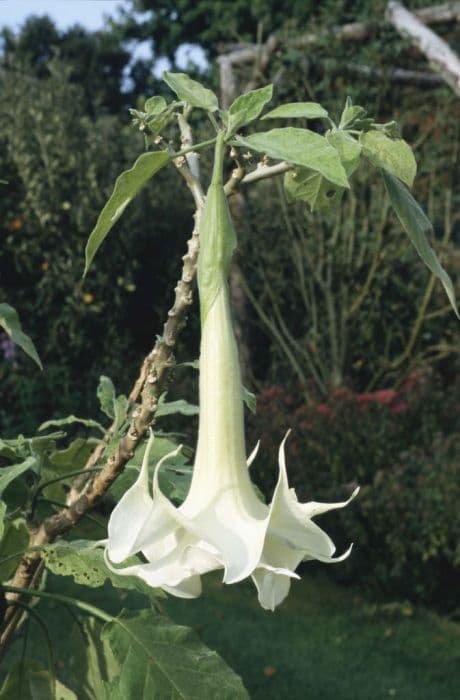Henbane bell Scopolia carniolica var. brevifolia

ABOUT
Scopolia carniolica var. brevifolia, commonly known as Henbane Bell, is a perennial herb with a striking and distinctive appearance. The plant has a rosette of dark green leaves that are broad and slightly wavy at the edges. These leaves often have a soft, almost velvety feel, and can sometimes show a faintly purplish hue on the undersides. Throughout its blooming period, the Henbane Bell produces bell-shaped flowers that hang pendulously from forked stems. The flowers are typically a pale yellow to creamy color, often with purplish veins running through them, which can give them a slightly eerie or otherworldly look. After the flowers, the plant forms seed capsules that contain numerous small seeds. The overall appearance of Henbane Bell is quite elegant and mysterious, with its soft-textured leaves and drooping, delicate flowers, which evoke an old-world charm. Its aesthetic is a unique blend of lush foliage and subtle floral colors, creating a visual appeal that is both enchanting and slightly haunting due to the plant's historical associations. The allure of this plant is further enhanced by its scarcity, as it is not commonly found in the wild or in cultivation.
About this plant
 Names
NamesFamily
Solanaceae
Synonyms
Henbane Bell, Alpine Scopolia, Siberian Scopolia
Common names
Scopolia brevifolia, Hyoscyamus scopolia, Scopolia atropoides.
 Toxicity
ToxicityTo humans
Scopolia carniolica, commonly known as Henbane Bell, is toxic to humans. The plant contains tropane alkaloids such as scopolamine, atropine, and hyoscyamine, which can cause anticholinergic syndrome if ingested. Symptoms of poisoning from Henbane Bell include dry mouth, difficulty swallowing, dilated pupils, blurred vision, increased heart rate, confusion, hallucinations, convulsions, and in severe cases, coma or death. Handling the plant may also cause skin irritation. Due to these substances, ingestion of any part of Henbane Bell can lead to serious health consequences, and medical attention should be sought immediately if poisoning is suspected.
To pets
Scopolia carniolica, known commonly as Henbane Bell, is toxic to pets. The presence of tropane alkaloids such as scopolamine, atropine, and hyoscyamine in the plant can lead to anticholinergic syndrome in animals. Symptoms of poisoning in pets may include restlessness, dilated pupils, difficulty breathing, ravenous appetite, disorientation, seizures, and in severe cases, coma or death. Any part of the Henbane Bell plant, if ingested by pets, is considered poisonous and could result in serious health impacts, requiring urgent veterinary care.
 Characteristics
CharacteristicsLife cycle
Perennials
Foliage type
Deciduous
Color of leaves
Green
Flower color
Brown
Height
1-2 feet (30-60 cm)
Spread
1-2 feet (30-60 cm)
Plant type
Herb
Hardiness zones
6
Native area
Europe
Benefits
 General Benefits
General Benefits- Landscape Aesthetics: Scopolia carniolica var. brevifolia, commonly known as Henbane Bell, adds unique visual interest to gardens with its striking foliage and bell-shaped flowers.
- Pollinator Attraction: The plant's flowers can attract bees and other pollinators which are crucial for the pollination of many plants, supporting biodiversity.
- Wildlife Habitat: Providing shelter and food resources, it can contribute to maintaining local wildlife populations, particularly beneficial insects.
- Erosion Control: The root system of Henbane Bell can help stabilize soil and prevent erosion on slopes and banks.
- Shade Tolerance: This variety can grow in semi-shaded areas where many other flowering plants might not thrive, offering greater landscaping flexibility.
- Drought Resistance: Once established, it often demonstrates resilience to periods of low water availability, making it suitable for xeriscaping.
- Seasonal Interest: Henbane Bell can provide seasonal color and visual interest, even in temperate climates with changing seasons.
- Cultural Significance: In some cultures or regions, the plant may have historical or traditional value, giving it a place in heritage gardens.
 Medical Properties
Medical Properties- Anticholinergic: Contains tropane alkaloids such as scopolamine which can act on the nervous system to reduce spasms and motility in the gastrointestinal tract.
- Anesthetic adjunct: Scopolamine, found in the plant, has been used in anesthetic procedures to decrease saliva and other secretions.
- Ophthalmic use: Historically, components like scopolamine were utilized for dilating pupils during eye examinations.
- Motion sickness: Scopolamine is known for its effectiveness in preventing the symptoms of motion sickness, although it is typically used in a synthetic form.
 Air-purifying Qualities
Air-purifying QualitiesThis plant is not specifically known for air purifying qualities.
 Other Uses
Other Uses- Scopolia carniolica, commonly known as Scopolia, has traditional uses in Eastern Europe for folkloric practices, where some people believe that planting it around one's home may offer protection against evil spirits.
- The root of Scopolia can be used in the preparation of natural insecticides, utilizing some of the plant's compounds that may be toxic to insects.
- In horticulture, Scopolia is cultivated for its attractive bell-shaped flowers, providing a unique aesthetic to gardens especially in shaded areas.
- Some crafters use Scopolia's dried flowers and seed pods in ornamental dried flower arrangements due to their interesting shape and texture.
- Scopolia's roots have been used for staining wood, providing a natural, earthy color from the pigments it contains.
- In art, the juices extracted from Scopolia's leaves and stems may serve as colorants for natural dyes in textiles and paper-making.
- Enthusiasts of photography might employ the bell-shaped flowers of Scopolia for macro and nature photography, capturing their unique form and structure.
- Some gardeners utilize Scopolia in companion planting, believing that its strong odor and toxic compounds might deter pests from more susceptible plants.
- The study of Scopolia offers educational opportunities, as biology and botany students can observe the plant’s growth, reproductive mechanisms, and ecological interactions.
- Scopolia can be integrated into environmental science practices, where its impact on biodiversity and soil chemistry in its native habitat can be investigated.
Interesting Facts
 Feng Shui
Feng ShuiThe plant Scopolia is not used in Feng Shui practice.
 Zodiac Sign Compitability
Zodiac Sign CompitabilityThe plant Scopolia is not used in astrology practice.
 Plant Symbolism
Plant Symbolism- Mystique: Scopolia, commonly known as Henbane Bell, has a mysterious aura linked to its hallucinogenic and toxic properties, which historically have been associated with witchcraft and sorcery.
- Caution: Due to its poisonous nature, the Henbane Bell symbolizes the need for caution and reminds us that not everything that is natural is harmless.
- Healing: Despite its toxicity, Henbane Bell has been used in traditional medicine, symbolizing the dual nature of plants to be both poisonous and healing.
- Transformation: The Henbane Bell's ability to induce altered states can symbolize personal transformation or the crossing of boundaries between reality and the unseen.
 Water
WaterHenbane bell should be watered when the top inch of soil feels dry to the touch, typically once every 1 to 2 weeks depending on environmental conditions. Use room temperature water and water the plant slowly around the base until excess water drains out from the bottom of the pot, which may be around a quart for a medium-sized plant. During the growing season in spring and summer, you might find the need to water more frequently, while in the dormant winter months, water less often. Avoid getting water on the foliage to prevent issues with leaf spot or fungal infections. Always check the soil moisture before watering to prevent overwatering and root rot.
 Light
LightHenbane bell thrives best in partial shade to filtered sunlight. It should be placed in a location where it receives bright but indirect light for most of the day, such as a spot near a north-facing or east-facing window where the direct sun won't scorch its leaves. While tolerant of slightly shadier conditions, prolonged deep shade can lead to leggy growth and fewer flowers.
 Temperature
TemperatureHenbane bell prefers a temperature range between 50 to 70 degrees Fahrenheit. It can withstand temporary dips down to 30 degrees Fahrenheit but isn't frost-tolerant and should not be exposed to temperatures below freezing for extended periods. The ideal condition for this plant is a consistently cool to moderate environment that mimics its natural woodland habitat.
 Pruning
PruningPrune henbane bell to remove faded flowers and any dead or damaged foliage to encourage bushier growth and more blooms. The best time to prune is in late winter or early spring, just before new growth begins. Depending on the plant size and condition, pruning may be required once a year or every other year to maintain shape and health.
 Cleaning
CleaningAs needed
 Soil
SoilHenbane bell prefers well-draining soil with a pH range of 6.0 to 7.0. A mix of loam, peat, perlite, and sand in equal parts would provide the optimal balance for drainage and fertility.
 Repotting
RepottingHenbane bell should be repotted every 2-3 years to refresh the soil and accommodate root growth, or as needed if it becomes root-bound.
 Humidity & Misting
Humidity & MistingHenbane bell thrives in moderate to high humidity conditions, typically ranging from 40% to 70%.
 Suitable locations
Suitable locationsIndoor
Keep henbane bell in bright indirect light with high humidity.
Outdoor
Plant henbane bell in partial shade; ensure soil drains well.
Hardiness zone
5-9 USDA
 Life cycle
Life cycleScopolia carniolica var. brevifolia, commonly known as Henbane Bell, begins its life cycle with seed germination, which typically occurs in early spring when soil temperatures warm. The seedlings develop into rosettes of leaves at ground level before sending up flowering stalks. Flowering occurs from late spring to early summer, with the plant producing bell-shaped, brownish-purple flowers that are pollinated by insects. After pollination, the plant develops fruit capsules that contain numerous small seeds, which mature by late summer to early fall. The seeds are then dispersed by various means, including animal movement and water, completing the reproductive stage. Henbane Bell is a perennial herb, so it can undergo this life cycle for several years, with the aboveground parts dying back during winter and regrowing from the rootstock the following spring.
 Propogation
PropogationPropogation time
Spring to Early Summer
Scopolia carniolica var. brevifolia, commonly known as Scopolia, is typically propagated through seed sowing. The most popular method for propagation of this perennial plant is to sow seeds in the late winter to early spring. Fresh seeds should be kept in a cold frame or under refrigeration to stratify for several weeks to enhance germination. Once stratified, they are sown shallowly in well-draining, moist seed-starting mix, lightly covered with soil, and placed in a cool, shaded area. Germination can be slow and irregular, so patience is necessary. Seedlings are carefully monitored for growth and once they are of sufficient size, they are transplanted into individual pots before being planted out in their final location in late spring or early summer.


![Calibrachoa [Aloha Classic Blue Sky]](/_next/image?url=https%3A%2F%2Fplants-admin.emdemapps.com%2Fimages%2Fplants%2F%2Fimages%2F604b636c3778b.png&w=640&q=75)
![Calibrachoa [Aloha Classic Gold]](/_next/image?url=https%3A%2F%2Fplants-admin.emdemapps.com%2Fimages%2Fplants%2F%2Fimages%2F604b6284c573e.png&w=640&q=75)
![Calibrachoa [Aloha Classic Tiki Soft Pink]](/_next/image?url=https%3A%2F%2Fplants-admin.emdemapps.com%2Fimages%2Fplants%2F%2Fimages%2F604b548e0a5ef.png&w=640&q=75)
![Calibrachoa [Cabaret Deep Yellow]](/_next/image?url=https%3A%2F%2Fplants-admin.emdemapps.com%2Fimages%2Fplants%2F%2Fimages%2F604b5f20ca3ef.png&w=640&q=75)
![Calibrachoa [Calibasket Radiant Orange]](/_next/image?url=https%3A%2F%2Fplants-admin.emdemapps.com%2Fimages%2Fplants%2F%2Fimages%2F604b536d43cb2.png&w=640&q=75)
![Calibrachoa [Caloha Classic Blue Velvet]](/_next/image?url=https%3A%2F%2Fplants-admin.emdemapps.com%2Fimages%2Fplants%2F%2Fimages%2F604b604884a75.png&w=640&q=75)
![Calibrachoa [Caloha Classic Honey White]](/_next/image?url=https%3A%2F%2Fplants-admin.emdemapps.com%2Fimages%2Fplants%2F%2Fimages%2F604b5f56e0beb.png&w=640&q=75)
![Calibrachoa [Caloha Classic Yellow Chocolate Ring]](/_next/image?url=https%3A%2F%2Fplants-admin.emdemapps.com%2Fimages%2Fplants%2F%2Fimages%2F604b538aede95.png&w=640&q=75)